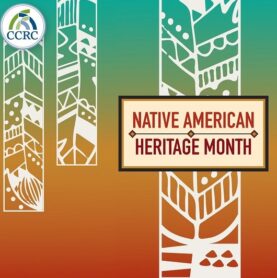Starting this Native American Heritage Month, we’d like to share that CCRC headquarters is located on Tongva, Chumash and Tataviam land. Modern day Chatsworth was once home to the Tongva village until the 1790s. Stoney Point, which is about five miles away, was known as a spiritual landmark that was used by shamans during the winter solstice celebration.
The first American Indian Day was celebrated in May 1916 in New York. Red Fox James, a member of the Blackfeet Nation, rode horseback from state to state to get endorsements from 24 state governments to have a day to honor American Indians.
Native American Heritage Month began as an effort to recognize and celebrate the unique contributions of the nation’s first Americans toward the growth and establishment of the United States. In 1990, President George H.W. Bush approved a joint resolution designating November as National American Indian Heritage Month. What’s now known as Native American Heritage Month is observed in November to recognize the achievements and contributions of Native Americans. Congress ultimately selected November since the month concludes Native Americans’ traditional harvest season and is generally a time of celebration and giving thanks.
President Biden’s office issued a statement commemorating the month: “Despite centuries of violence and oppression, Native peoples remain resilient and proud. Today, Native Americans are essential to the fabric of the United States. They serve in the United States Armed Forces at higher rates than any other ethnic group. They continue to steward so many of our great lands. Their contributions to science, humanities, arts, public service, and more have brought prosperity for all of us. Their diverse cultures and communities continue to thrive and lead us forward.” Read the full statement here.
Native Americans were granted American citizenship in 1924. The Indian Citizenship Act was signed into law by President Calvin Coolidge on June 2, 1924. Some Native Americans were already considered U.S. citizens because of the 1887 Dawes Act, which was passed to help spur assimilation and granted citizenship to those who accepted land grants. Even though Native Americans were given full citizenship, many were still denied the right to vote.
This year’s theme is Celebrating Tribal Sovereignty and Identity. Tribal sovereignty ensures that any decisions about Tribes with regard to their property and citizens are made with their participation and consent. The federal trust responsibility is a legal obligation under which the United States “has charged itself with moral obligations of the highest responsibility and trust” toward Indian tribes. Read more here.
Did you know:
- In the U.S., 26 state names are derived from Native American words for rivers.
- Over 80 Native American appointees serve across Biden’s Administration and in the Federal courts.
- 7.2 million – The number of American Indian and Alaska Natives in the United States in 2022. Alaska and Oklahoma have the largest population.
- The Navajo tribe is the largest in the U.S. with over 320,000 members.
Learn more about California territories by checking out this link: https://native-land.ca/


